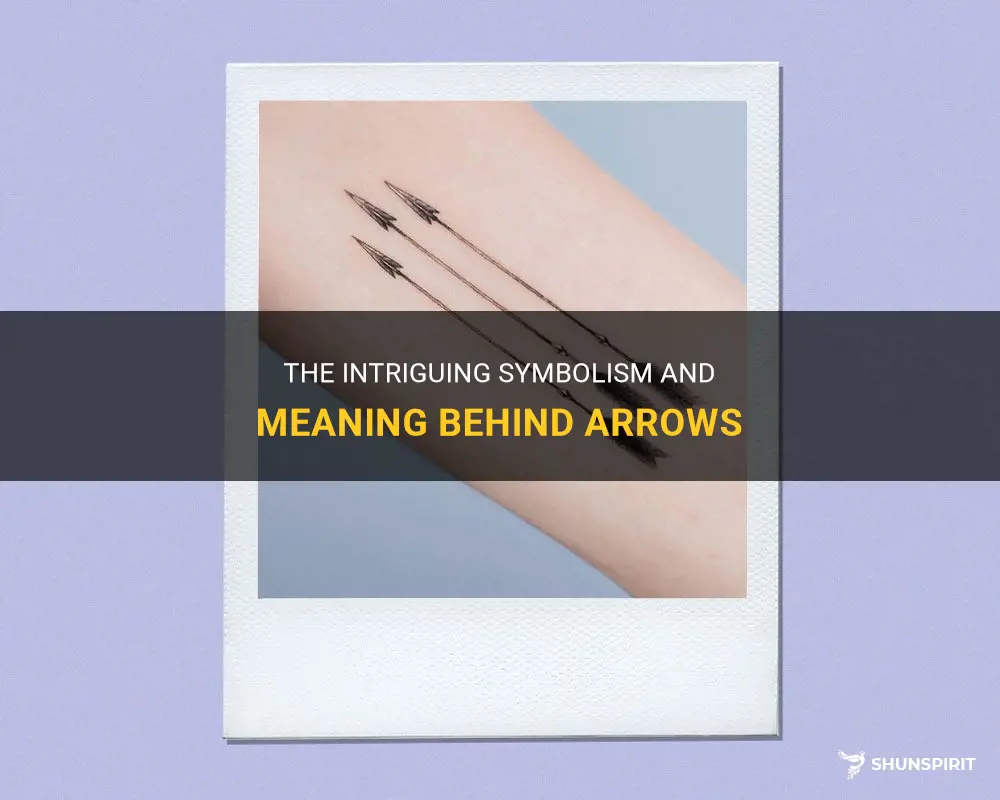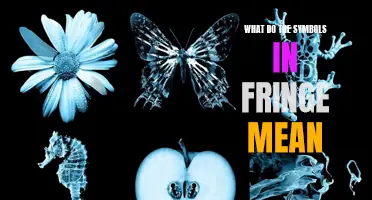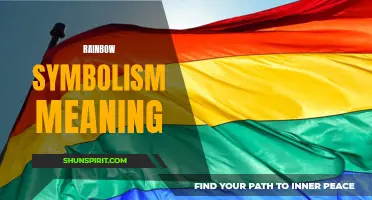
Arrows have always captivated our imagination, whether it's in ancient mythologies, tribal cultures, or modern movies. With their characteristic design and rich symbolism, arrows hold countless meanings across different cultures and time periods. From representing direction and purpose to signifying protection and strength, arrows are more than just weapons or tools – they are powerful symbols that can guide us through life's journey. Join us as we explore the deep and fascinating meanings behind arrow symbolism and uncover the hidden messages these simple yet intricate designs convey.
What You'll Learn
- What is the history and cultural significance behind arrow symbolism?
- How does the meaning and symbolism of arrows vary between different cultures and traditions?
- In what ways are arrows used as symbols in art and literature?
- What are some common interpretations and meanings associated with arrows in symbolism?
- How have contemporary interpretations of arrow symbolism evolved and changed over time?

What is the history and cultural significance behind arrow symbolism?
The history and cultural significance of arrow symbolism can be traced back to ancient civilizations and has continued to play a significant role in various cultures and societies around the world. Arrows have been used as weapons, tools, and symbols in different contexts, symbolizing courage, direction, protection, and strength.
In ancient times, arrows were primarily used as weapons for hunting and warfare. They were crafted with precision and skill, and their use required strength, accuracy, and bravery. Arrows were often seen as a symbol of courage and bravery in battle, representing the warrior's ability to overcome obstacles and achieve victory.
The ancient Greeks and Romans associated arrows with their gods and goddesses. In Greek mythology, the god Apollo was depicted as carrying a bow and arrow, symbolizing his role as the god of archery, music, prophecy, and healing. Artemis, Apollo's twin sister, was also depicted with a bow and arrow, representing her role as the goddess of the hunt and the protector of young girls.
In Native American cultures, arrows were commonly used in hunting and warfare. The Native Americans believed that arrows had spiritual power and were often used in ceremonies and rituals. For example, the Plains Indians believed that the arrow symbolized the connection between the physical and spiritual worlds, and hunters would perform rituals to ensure a successful hunt and show gratitude for the animals they killed.
In Chinese culture, the arrow symbolizes progress, determination, and direction. The Chinese word for arrow, "shi," sounds similar to the word for ambition, giving it a positive connotation. Arrows are often used in Chinese art and calligraphy to represent the pursuit of goals and aspirations.
In modern times, the arrow symbol has gained popularity as a tattoo design, often representing strength, protection, and direction. Many people choose arrow tattoos to remind themselves to stay focused, overcome obstacles, and stay on track towards their goals. The arrow tattoo can also symbolize a sense of personal growth and moving forward in life.
In conclusion, the history of arrow symbolism is deeply rooted in ancient civilizations and continues to play a significant role in various cultures and societies today. Arrows symbolize courage, direction, protection, and strength, and they have been used as weapons, tools, and symbols throughout history. Whether used in hunting, warfare, religious ceremonies, or as tattoo designs, the arrow remains a powerful symbol with deep cultural significance.
Decoding the Hidden Meanings Behind TikTok's Live Symbols
You may want to see also

How does the meaning and symbolism of arrows vary between different cultures and traditions?
Arrows have been used as weapons and tools for thousands of years, and their meaning and symbolism have evolved and varied greatly across different cultures and traditions. From ancient times to the present day, arrows have held significance in numerous aspects of life, including warfare, hunting, spirituality, and art.
In many cultures, arrows have been synonymous with war and conflict. They represent strength, power, and the ability to strike from a distance. In ancient Greece, the god Apollo was often depicted holding a bow and arrows, symbolizing his role as the god of archery and warfare. Similarly, in Norse mythology, Odin, the king of the gods, possessed a magical bow and arrows that never missed their target. The association between arrows and war can also be found in Native American cultures, where the bow and arrow were essential tools for hunting and defense.
Apart from their martial symbolism, arrows have also held spiritual significance in various cultures. In Hinduism, the deity Kamadeva is portrayed as carrying a bow and arrows, representing his role as the god of love and desire. In this context, arrows symbolize the power to ignite passion and attraction. In ancient Chinese philosophy, arrows are often associated with balance and harmony. The concept of the "Way of the Arrow" emphasizes the importance of finding the right path and staying true to it, much like an arrow flying straight towards its target.
In Native American traditions, arrows are seen as sacred objects that connect the physical and spiritual realms. They are often used in rituals and ceremonies as a means of communication with the divine. Native American tribes also believe that each arrow possesses its own spirit and unique power, making it a potent symbol of protection and guidance.
Arrows have also played a significant role in art and design. In heraldry, arrows are commonly used as symbols of swiftness, agility, and precision. In tattoo art, arrows can represent direction, ambition, or a personal journey. They can also symbolize resilience and the ability to overcome hardships, as the phrase "being pulled back before being launched forward" suggests.
It's important to note that while there are several common themes associated with arrows, their precise meaning and symbolism can vary even within the same culture or tradition. The context in which arrows are used, as well as the accompanying symbols and imagery, can greatly influence their interpretation. Therefore, it is crucial to consider the specific cultural and historical context when understanding the symbolism of arrows.
In conclusion, the meaning and symbolism of arrows vary between different cultures and traditions. While they are often associated with warfare and conflict, arrows also hold spiritual significance and can represent love, balance, and guidance. Additionally, they have been used as symbols of swiftness, ambition, and resilience in various forms of art and design. To fully comprehend the meaning of arrows, one must explore the specific cultural and historical context in which they are used.
The Deep Symbolism and Meaning Behind Hummingbirds
You may want to see also

In what ways are arrows used as symbols in art and literature?
Arrows have been used as symbols in art and literature for centuries, representing various concepts and ideas. Their presence in these forms of expression can provide deep meaning and insight into the human experience. In this article, we will explore the different ways arrows have been used as symbols in art and literature.
One common representation of arrows in art and literature is their connection to direction and guidance. Arrows can act as signposts, pointing the way forward or indicating a path to be taken. This can be seen in ancient maps or artistic depictions of exploration, where arrows are used to guide travelers to their destination. Arrows symbolize the need for direction and the quest for knowledge and discovery.
Another way arrows are used as symbols is to represent strength and power. In ancient mythology, gods and warriors were often depicted with arrows, as they were seen as powerful weapons that could conquer and defeat enemies. In art, arrows can be used to depict strength and determination, often in depictions of heroes or allegorical figures. Arrows can convey the idea of being focused, precise, and unstoppable.
Arrows can also represent love and desire in art and literature. In classical mythology, Cupid is often depicted with a bow and arrow, shooting his arrows at unsuspecting individuals to make them fall in love. This imagery has been widely used in literature and art to represent the power of attraction and the longing for romantic connection. Arrows can symbolize the arrow of love piercing the heart, indicating the intense emotions and desires associated with love.
In addition to these meanings, arrows can also symbolize conflict and danger. In ancient times, arrows were used as weapons of war, wreaking havoc and causing destruction. In literature, arrows can represent the threat of violence or the danger of a particular situation. Arrows can be used to heighten tension and create a sense of urgency in a story or painting, adding a layer of suspense and drama.
In summary, arrows have been used as symbols in art and literature to represent various concepts and ideas. They can symbolize direction and guidance, strength and power, love and desire, as well as conflict and danger. The presence of arrows brings depth and meaning to artistic and literary works, allowing readers and viewers to connect with deeper aspects of the human experience.

What are some common interpretations and meanings associated with arrows in symbolism?
Arrows have been used as symbols in various cultures and traditions throughout history. They are often associated with concepts such as direction, speed, power, and protection. Arrows can hold different meanings depending on the context in which they are used. Here are some common interpretations and meanings associated with arrows in symbolism:
- Direction and Guidance: Arrows are frequently used as symbols of direction and guidance. Just as an arrow points towards a specific target, it represents the idea of moving forward and making progress in life. Arrows can symbolize finding one's path, making choices, and staying focused on one's goals.
- Strength and Power: Arrows are often portrayed as powerful and unstoppable. In mythology and folklore, they are associated with gods and heroes who possess great strength and skill. The act of shooting an arrow requires strength and precision, symbolizing the ability to overcome obstacles and achieve success.
- Protection and Defense: In Native American traditions, arrows are seen as protective symbols. They represent the warrior's weapon, used to defend and protect oneself and the community. Arrows can also symbolize the power to ward off negative energy and protect against harm and evil forces.
- Love and Cupid's Arrow: In the realm of love and romance, arrows are closely associated with Cupid, the Roman god of love. Cupid is often depicted as a cherubic figure armed with a bow and arrow, shooting people in the heart to make them fall in love. In this context, arrows symbolize the power of love, attraction, and the ability to capture someone's heart.
- Speed and Swiftness: Arrows are known for their speed and swiftness when released from a bow. As a symbol, they represent quick and efficient action, agility, and the ability to make rapid progress. Arrows can be seen as a reminder to be swift in making decisions and taking action.
- Transformation and Change: In some spiritual and philosophical traditions, arrows are associated with transformation and change. They represent the necessary force or catalyst required to initiate personal growth and transformation. Arrows can symbolize the willingness to let go of the old and embrace new experiences and possibilities.
- Connection and Unity: Arrows can also symbolize the concept of connection and unity. In some indigenous cultures, arrows are depicted with multiple feathers to represent different tribes or individuals coming together in harmony. Arrows can symbolize the power of collaboration, teamwork, and the strength that comes from unity.
In conclusion, arrows hold a variety of interpretations and meanings in symbolism. They can represent direction, strength, protection, love, speed, transformation, and connection. The specific meaning of an arrow depends on the cultural context and the symbolism it is associated with. Whether used in myths, rituals, or as decorative symbols, arrows continue to hold profound significance in human imagination and belief systems.
The Hidden Symbolism Behind the Mercedes Benz Logo Revealed
You may want to see also

How have contemporary interpretations of arrow symbolism evolved and changed over time?
Arrow symbolism has been prevalent in human cultures for thousands of years. The arrow, being a universal weapon and tool, has represented various ideas and concepts throughout different periods and cultures. In contemporary times, the interpretation and meaning of arrow symbolism have evolved and changed significantly.
In ancient civilizations, arrows were used primarily for hunting and warfare. They were seen as powerful weapons that could bring down a mighty foe or provide sustenance for survival. In these early interpretations, arrows symbolized strength, courage, and survival instincts. They represented the primal nature of human beings and their ability to adapt and overcome challenges.
As civilizations progressed and became more organized, arrow symbolism started to encompass additional meanings. Arrows were often used as symbols of direction and guidance. In many cultures, arrows were associated with gods and goddesses who provided guidance and protection. This interpretation of arrows as guides and protectors can still be seen today, as arrows are commonly used in road signs and wayfinding systems.
Furthermore, the arrow has also become a symbol of love and attraction. This interpretation can be traced back to ancient Greek mythology, where Cupid, the god of love, was often depicted with a bow and arrow. In this context, arrows are seen as tools of desire and passion, as they have the power to make someone fall in love. This symbolism has been perpetuated in contemporary culture, with arrows often being used in romance-related imagery and designs.
In recent years, arrow symbolism has taken on new meanings in popular culture and social movements. Arrows have become associated with strength and resilience, particularly in feminist and empowerment contexts. The arrow is often seen as a symbol of progress and moving forward, representing the determination and drive to overcome obstacles. Additionally, arrows have been used as symbols of unity and solidarity, as they can only reach their target when multiple arrows are aligned and aimed in the same direction.
The evolution and changing interpretations of arrow symbolism reflect the dynamic nature of human culture and society. As our understanding of the world and our values shift, so do the meanings we attribute to symbols such as the arrow. From representing primal instincts and survival to guidance and love, and now to strength and unity, the arrow continues to captivate and inspire us with its versatile symbolism.
The Meaning Behind the V in a Circle Symbol
You may want to see also
Frequently asked questions
In various cultures and religions, the arrow is often seen as a symbol of strength, power, and determination. For example, in Native American cultures, the arrow is considered a powerful symbol of protection and defense. In Hinduism and Buddhism, the arrow is associated with the god of love and desire, Cupid or Eros, who is depicted as shooting love arrows to make people fall in love. In Christianity, the arrow is often associated with Saint Sebastian, who was said to have been martyred by being shot with arrows.
In tattoo art, an arrow often symbolizes direction, focus, and ambition. It can be a reminder to stay focused on your goals and strive for success. Additionally, an arrow can represent moving forward and leaving the past behind. Some people may choose to get an arrow tattoo as a symbol of overcoming challenges or obstacles in their lives. The arrow can also be a symbol of protection or defense, serving as a reminder to stay strong and resilient.
A broken arrow is often seen as a symbol of peace or the end of conflict. It is derived from a Native American tradition in which a broken arrow would be placed between two warring tribes as a sign of peace and a promise to end hostilities. In modern times, the broken arrow symbol is often used as a logo or emblem for peace organizations or movements. It can also represent healing, forgiveness, and reconciliation, as it signifies a willingness to mend broken relationships and work towards harmony.







